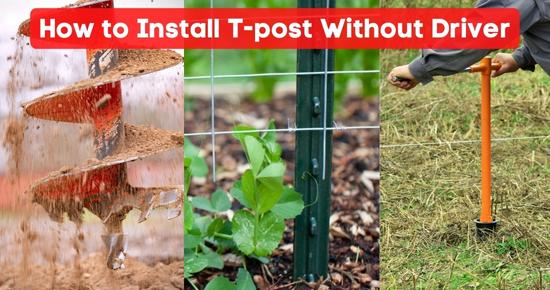T-posts are made to be directly driven into the ground. A manual post-driver(pounder) is commonly used to drive metal posts. But if you don’t have one, you’ll need another tool to drive T-posts depending on the number of posts & ground conditions.
For example:
- A sledgehammer can be used to drive a few small-sized T-posts on soft ground.
- For heavy-duty large T-posts, you can use a closed-end metal pipe or tube (i.e., cast iron pipe) in soft or hard ground,
- A bucket tractor or loader can be highly useful for driving a large number of heavy-duty T-posts, especially on hard ground.
- Although it’s not recommended to install T-posts by digging holes, you can dig pilot holes to make the installation easier & to verify if the post can be driven into the ground or not.
In this post, we’ll guide you through all the tools & methods to install T-posts without a driver:
Complete guide to install T-post without driver:
To install a t-post without a driver/pounder, you can follow any of these methods:
- First, mark the part of T-posts that will go underground. Then, decide on post spacing according to your fence weight & expected pressure.
- If you don’t have a post-driving tool, use a similar closed-end heavy metal pipe as a post-drive (for a few T-posts).
- You can also use a sledgehammer on soft ground.
- In another way, dig tiny holes, water the ground & then easily drive T-posts with a sledgehammer.
- For a large number of posts, take a tractor or loader equipped with a bucket & hit it from the top of T-posts.
- In hard ground, you can dig pilot holes using a thin bit auger drill, masonry drill, or a jackhammer to make T-post installation easier.
- If you have a metal pipe, you can also convert it into a post-driver.
Tip:
- If the soil is moist, driving t-posts will be easier & vice versa.
- The more part of T-posts you drive, the fence will be more stable.
- You must incorporate wood posts if you are installing heavy-duty, heavy-weight fences, such as agriculture land fences.
- You can’t use a sledgehammer to drive T-posts. It’ll take a very long time, and there are a lot of chances it’ll slip and cause injury.
How deep to drive T-posts?
Driving 1/3 of the T-post (2-3 feet) is recommended for greater strength in your fence. As per rules: “1/3 to 1/2 of the post out of the ground should be driven into the ground“.
For example, a 6-foot T-post should be driven at least 1.5-2 feet. A 10 feet T-post must go at least 3 feet under the ground.
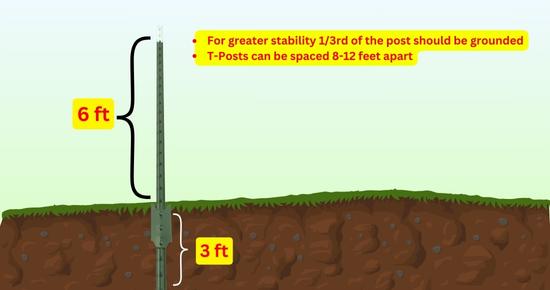
T-post Spacing:
Depending on the fence load, t-posts should be spaced a maximum of 8 to 12 feet.
Read the complete step-by-step guide below:
Method 1: Drive T-posts with a closed-end tube/pipe
If you don’t have a post-driver, a closed-end heavy metal pipe can work the same. Same as a manual post driver, you’ll have to lift the metal pipe upward & pull it downward. Due to the weight of the metal pipe, posts will get driven into the ground.
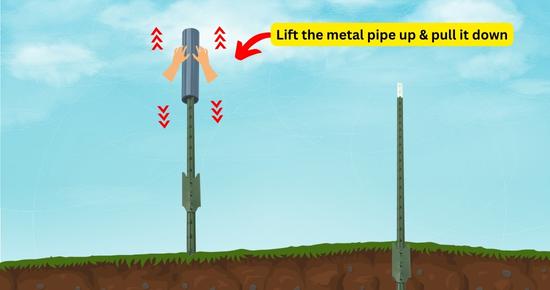
Steps:
- Vertically align the t-post.
- Place the pipe over the t-post.
- Lift the pipe up and pound it down forcefully.
- Repeat until the t-post is driven up to the desired depth.
Tip: To make installation easier without any tool, adequately water the spot & let it soak.
Method 2: Drive T-posts with a Sledgehammer:
Sledgehammers are used for demolition purposes due to their heavier weight. Many people suggest using a sledgehammer to drive T-posts, but It’s not recommended except for certain conditions. For example, it can be used to drive a few medium-sized T-posts on soft ground.
Drawbacks of using a sledgehammer for driving T-posts:
- If it slips, it can cause injuries. I’ve witnessed a guy cut himself pretty badly by getting his hand pinched between a sledgehammer and T-posts while hitting posts.
- It’s not ideal for installing a large number of T-posts.
- A sledgehammer is unsafe for driving longer & thicker heavy-duty T-posts, especially on the hard ground. Larger T-posts, such as a 10ft, must be driven up to 2.5-3 feet. A hammer won’t help you drive T-posts deep in hard ground.
- In the rocky ground, driving T-posts is almost impossible & may bend the T-posts.
Precautions:
As a sledgehammer is not recommended for driving T-posts, you should know some precautions if you still want to go with this.
- Wear gloves for safety.
- Use a heavy-duty wide-head sledgehammer with a long head.
- To make installation safe & easier, stand higher such that your upper body is above the T-post & stay a little far from the posts.
- Don’t hold the posts with your hand to keep them straight. Ask someone to hold the T-posts straight or dig a pilot hole to anchor the posts. Use both your hands to grip the hammer firmly.
- Don’t lift the hammer too much. If you hit it from a greater height, It can slip & may hit your body.
- Hit the hammer from the exact top of the T-posts. If you hit the hammer in a round motion, it may slip after collision.

Steps to install T-posts with sledgehammer:
- Dig pilot holes to hold the post straight, or ask someone to hold the posts.
- Use a ladder to stand higher than the upper end of T-posts, but stay a little away.
- Hold the hammer’s handle from a little distance so that if it slips, it doesn’t hurt your hands.
- Don’t lift the hammer too much & hit it at the exact top of the T-post & repeat until the desired height of the T-post is driven into the ground.
Method 3: Dig holes, & soak it with water
In case someone doesn’t have a post-driving tool, as a DIY alternative, dig a pilot hole and water it adequately & then driving the post will be quite easier. However, make sure that the area you’re working in has access to water.
Drawback:
- This method works for lightweight fence fixtures.
- This method takes a lot of time as you’ll have to wait until the water soaks into the soil. Same as after installing T-posts, to attach the fence, you’ll have to wait until the ground gets dried.
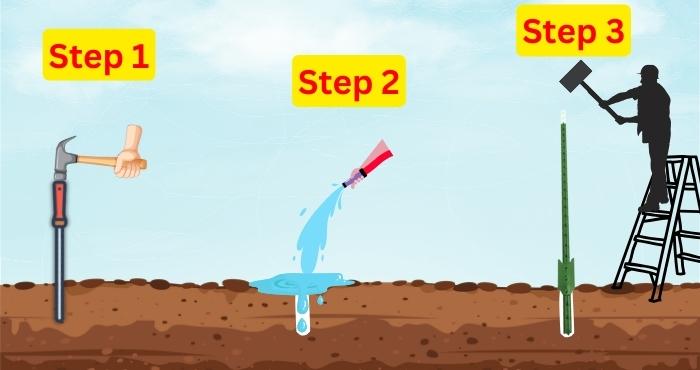
Steps to Install T-posts:
- Simply take a long & thick(around 1-inch) metal rod-type object such as a cold chisel and a hammer. Or if you have a demolition hammer, it’ll also work.
- Drive the metal rod into the ground using a hammer. Similarly, dig pilot holes in each spot where you have to install T-posts.
- Now you’ll need plenty of water. Take a water hose pipe or any other option you have & adequately water all the holes & the ground nearby.
- Let the water soak into the soil. It can take up to multiple hours or up to the next day.
- After the water is completely soaked into the soil & the ground has become soft. Take the T-post and pinch it into the hole.
- Use a sledgehammer to drive the post. Posts will easily be driven into the ground as the ground has turned soft due to excessive moisture.
- Let the ground completely dry before installing the fence to make the T-post securely anchored into the ground.
Tip: An auger or masonry drill can also be used to dig pilot holes for T-posts.
Method 4: Make a homemade post-driver:
If you have a heavy metal pipe (5kg or more) with 3 inches or greater diameter, you can use it to make a post driver.
You’ll need 3 things:
- A metal pipe
- A metal cap or piece of metal to close one end.
- Two round-shaped smaller/thin metal pipes as handles.
You just have to weld the cap/piece of metal at one end and weld the smaller round pipes at both sides of the metal pipe.
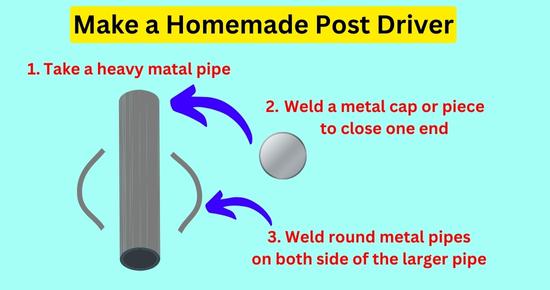
Method 5: Dig post holes with a digging bar:
A digging/tamping bar is also a cost-effective tool for digging post holes. However, this method takes a little more time & energy & is ideal for temporarily installing T-posts for lightweight fences.
A digging bar will take 5-10 minutes per post hole, depending on the ground condition, strength, and experience of the person.
Steps:
- Choose a spot to install t-posts.
- Firmly hold the bar with both hands & hit the sharp(V) end on the ground.
- After each hit, move the rod left and right(back & forth). The soil will move aside, turning the hole deeper.
- Keep digging until the hole is at least 2-3 feet deep. Measure the depth of the hole by inserting the t-post inside.
- Place the t-post vertically straight in the hole. Make sure that the studs/hooks are facing the right direction.
- At last, fill the hole with soil & press with your shoes or a hand compactor(tamper tool).
Tip: A heavy stone is underground if your elbow vibrates while digging. In such conditions, dig a few inches away.
Method 6: Drive T-posts with the tractor
If a tractor loader or excavator is available and you know how to operate it, you can drive hundreds of t-posts even on hard ground with minimum effort.
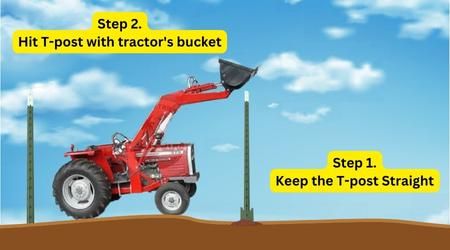
Steps:
- Ask someone to hold the t-post.
- Lift the tractor’s bucket and hit it at the top of the t-post.
- Lift and hit again. Repeat.
- Use a level tool to check if the post is straight or inclining.
- If the T-post is leaning, push it in the right direction.
- T-post will be driven within a minute.
Note: Hold the t-post until it is driven a few inches & doesn’t need support.
Method 7: Dig pilot holes with drills/auger drills:
In hard/rocky ground, you should drill pilot holes to check if the posts can be driven up to the desired depth. Pilot holes also make the installation easier. For this purpose, you can use a missionary drill or thin auger drill bit(1inch diameter). Auger drill is a powerful tool to quickly dig post holes, especially in rocky(hard) ground.
A normal drill auger with a 1-inch wide bit will be perfect for digging holes for t-posts. However, for rocky ground, you may need a heavy-duty auger.

After digging holes, insert the T-post into the hole, all facing the same direction. Then, pound the post completely. Fill the hole with sand & use a hand compactor to compress the soil.
Attaching different fences to T-posts
With T-posts, you can attach any type of wire fence, high tensile or barbed wire, electric fence, snow fence & wood panel fence.
1. Wire fences
T-post clips are most commonly used to attach any type of wire fence, such as welded wire, chain link, or woven fence to T-posts. You can also attach high tensile wire fences or barbed wire with T-posts.
Except for T-post clips, you can also use metal wire pieces or zip ties(for short term) to attach wire fences to T-posts.
To install fence clips on T-posts:
- Warp the clip around the T-post above a stud.
- Then, catch the nearest fence wire in the hooks of the T-post clip.
- Use a clip bender or plier to twist t-post clips, which will grip fence wires with the t-post.
- Other than T-post clips, you can use pieces of hard metal wire to attach fence wires to T-posts/
Tip: Use at least 3 clips per t-post, 1-1.5 feet apart from each other.
2. Electric fences:
To install electric fences on T-posts, you’ll need to mount T-post insulators equal to the number of strands. They should be installed at the same height on each T-post. Insulators keep the live fence wires from short-circuiting with meal posts.
3. Snow fences:
You can install snow fences with T-posts using thick gauge metal wire pieces or heavy-duty zip ties. Snow fences should be installed toward the wind source side of the posts.
4. Wood fence:
T-post wood adapters are helpful for attaching wood panel/board fences to T-posts. T-post adapters get mounted on T-post & screws are drilled through holes on adapters into wood.
Frequently Asked Questions
1. How to drive t-posts in rocks?
To drive t-posts on rocky ground, you can use any heavy-duty post driver such as an electric, gas-powered or hydraulic post-pounder or bucket tractor. However, it’s better to drill pilot holes & check if the T-post can go deep in the ground.
2. What is a fence post driver/pounder/hammer?
A post-driver(pounder) is a heavy-duty manual tool used to drive metal posts, i.e., t-posts, u-posts, and round metal posts. It’s a cylindrical pipe closed from the top, weighs around 20 pounds (9 kg), and has two handles for holding it. Post-driver takes less time than other manual digging tools but requires a lot of strength.
3. How to remove T-posts?
A t-post puller is most commonly used to remove t-posts from the ground.
- Adjust the t-post puller’s c-shape lock at the possibly lowest stud(hook) on the t-post.
- Apply your body weight/force on the arm of the puller downward.
- T-post will be pulled out of the fence.
If the ground is extremely hard, don’t lock the lowest t-post hook, and don’t put a lot of force on the handle. The t-post could bend.
4. How to hang a gate on a T-post?
T-post hinges are used to hang gates with T-posts. Also, the gate must have hinges welded or mounted to it.
- Simply slide the T-post hinges over the T-post.
- Take them to the desired height & lock them to the T-post stud.
- At least hook the gate hinges to the T-post hinges.
5. How to install barbed fence wire with T-post?
We can use T-post clips or a hard metal wire to attach barbed wire fence to T-posts. T-post clips wrap around the T-posts & the hooks at the ends catch the fence wires. At last, we use a clip bender or plier to twist the clip’s ends(hooks) around the barbed wires.
Similarly, you can also use a piece of hard metal wire. Bend the wire in a T/U shape, wrap it around the T-post, and twist the hooks around the barbed wires.
Conclusion
Without using a post driver, there are several other methods to drive T-posts, such as using a closed-end pipe(for a few T-posts) & a tractor or loader equipped with a bucket(for a large number of posts). In rocky ground, you can also use a drill, auger drill, or demolition hammer to drill pilot holes.
As a fence installer, I would suggest you invest at least in a manual post-driver as it is quite helpful to install T-posts & U-posts & serves you whenever you have to work with fences. An automatic post driver is also useful for large & continuous fencing projects.
Read the complete post, and if you are still confused about anything or know any other useful method, share it with us.
Related Guides:

